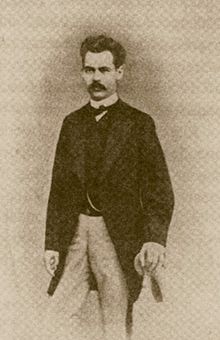Lassallescher General German Workers' Association
The Lassallsche Allgemeine Deutsche Arbeiterverein ( LADAV ) was a workers 'party in the tradition of Ferdinand Lassalle , which split off from the General German Workers' Association (ADAV) in 1867 . The organization initially existed until a temporary reunification with the parent party in 1869. The party finally disintegrated in 1872.
Spin-off from ADAV
After the death of Ferdinand Lassalle in 1864, there were internal party disputes in the ADAV. The played Countess Hatzfeld , which had temporarily been the mistress of Lassalle and his party had financial support from the very beginning a substantial role. Her main concern was to prevent all content and organizational changes and to continue following Lassalle's course. The final break with the ADAV took place on the occasion of resolutions that had been taken at the general assembly of the party in Braunschweig in May 1867. According to the constitution of the North German Confederation, Lassalle’s central demand for universal suffrage was achieved at least in this part of Germany and therefore had to take a back seat. In addition, Johann Baptist von Schweitzer, one of the Countess's sharpest internal opponents, became President of the ADAV, who immediately began to expel those members who had participated in the "women intrigue". Countess Hatzfeldt assessed these and other measures as a breach of the statutes left by Lassalle.
They and their supporters drew the conclusions from this and called on the ADAV communities that wanted to adhere to the old statutes to elect a president and delegates for a constituent general assembly in Dresden on June 16, 1867. About a fifth of the ADAV members had joined the new organization. Since the official club information is often embellished, only well-founded estimates are possible. There were perhaps 34 local groups - called parishes - with just over 3,000 members. The organization subsequently proved to be extremely fragile. So it soon lost more than half of its members in northern Germany. The communities were concentrated mainly in Saxony around Chemnitz , Bremen and in Altona - Wandsbeck , in the Lower Weser region and in some places in Schleswig-Holstein .
Organization and regional focus
After all, with the financial support of Countess Hatzfeldt, President Friedrich Wilhelm Emil Fösterling succeeded in winning the Reichstag constituency of Chemnitz in the election for the Reichstag of the North German Confederation . In 1869 , Fritz Mende also received a parliamentary mandate in the Freiberg constituency through a by-election .
Friedrich Ernst Wilhelm Fösterling became the first president of the LADAV. However, the actual management soon passed to Mende, who also officially became the club's president in 1868. Initially, Mende was able to stop the decline in membership. A wide range of agitation activities also contributed to this. In the Lower Rhine region , for example, it was possible to found new communities in the vicinity of the weaving town of Mönchengladbach . The official figure of around 13,000 members is, of course, grossly exaggerated. Realistic estimates are around 3,000.
However, the further expansion suffered from a strongly self-centered inner party life. In addition to the rigid adherence to Lassalle's principles, the fight against agitators and subversive elements played an important role in the general assemblies. In addition, the association hardly had any noteworthy membership fees, but remained dependent on Countess Hatzfeldt's assets. This played an important role in the place of President Mende, who often fell ill.
Even if there was no direct competition with the ADAV due to other regional focuses, the mutual attacks and polemics with the help of the respective party press were a characteristic of the mutual relationship. Common to both organizations was their critical stance towards trade unions and strikes as an expression of particularist workers' interests. For both groups, the focus was on political organization.
Reunion, new division and agony
In view of the hostility that had previously been expressed to one another, the announcement of reunification in mid-1869 came as a complete surprise to party members of both organizations. In the LADAV camp, this led to the separation of the most important community in Chemnitz. Several reasons played a role on the LADAV's side. This includes the failure to establish itself vis-à-vis the ADAV as the actually legitimate Lassallan organization. In addition, the financial situation of the association was catastrophic, especially since Countess Hatzfeldt had announced that she would withdraw.
However, the hopes of Mendes and Hatzfeldt turned out to be an illusion that the ADAV would again follow an orthodox course based on Lassalle after reunification. As early as October 1869, the renewed split became apparent. The LADAV was then re-constituted in January 1870. Despite some successes, its importance continued to decline. After Fösterling's death, who was at the top again in the final phase, on March 10, 1872, the association gradually fell asleep.
literature
- Protocols and materials of the General German Workers' Association (including splinter groups) . Reprint ed. by Dieter Dowe . JHW Dietz Nachf., Berlin, Bonn 1980. ISBN 978-3801-22094-5
- Toni Offermann: The first German workers' party. Organization, distribution and social structure of ADAV and LADAV 1863-1871 . ISBN 3-8012-4122-X (book edition + CD-ROM)
- Franz Osterroth , Dieter Schuster: Chronicle of the German social democracy. Vol. 1: Until the end of the First World War . Bonn, Berlin, 1975.

